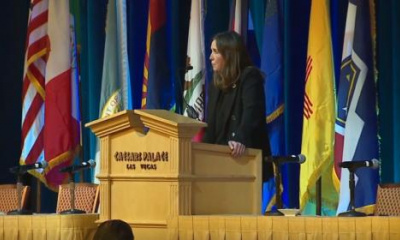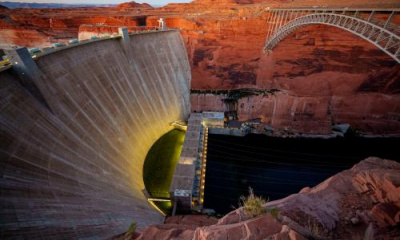A new way to snow survey that originated at NASA is flying over Utah for the first time this year.
Airborne Snow Observatories’s founders, including Chief Technical Officer Jeff Deems, developed the technology while working at NASA’s Jet Propulsion Laboratory in 2010 before spinning off as a private company in 2019.
Airplanes cruising around an altitude of 25,000 feet scan the snowy ground below with a web of lasers miles wide.
“We fly back and forth — basically mowing the lawn, pattern-wise — so that each of those data swaths overlaps,” Deems said.
Airborne launched its first Utah flight in March over the south slopes of the Uinta Mountains, where he said it can take over four hours to cover the entire area.
The idea is to capture a more accurate, more complete picture of how much snow Utah’s mountains have, which then informs forecasts, computer models and ultimately local water managers. Having detailed data — and more confidence in it — can be a big help as they make decisions about how to use or conserve their supplies, he said.
That’s especially true in a fast-growing, dry state like Utah, where 95% of the water supply comes from snowpack and big water sources like the Great Salt Lake and Colorado River face mounting challenges.
“The technology came together — and the opportunity at NASA came together — at the same time that our water resources are really seeing a lot of crunch, not only due to population but also due to climate change,” Airborne co-founder and CEO Tom Painter said.
The plane is equipped with LiDAR, which Painter described as high-altitude laser pointers directed toward Earth. They beam down, hit the surface and send back a response about how far away that surface is. Because Airborne has already mapped the same area with no snow on a previous flight, they’re able to take the difference between those two elevations to find the snow depth. Then they use snow density modeling to figure out the snow water equivalent, a measure of how much water it holds.
The big difference between this and traditional snow survey methods is that the lasers cast a wide net.
“For years, we have been forced to imagine how the mountain snowpack evolves across the landscape,” Deems said. “Now, with this new approach, we can actually see what the snowpack looks like at very high resolution. We have a snow depth measurement every 10 feet, everywhere across the landscape.”
Each nanosecond-speed pulse of laser light spreads out as it nears Earth, Deems said. So by the time it hits a tree, rock or snow drift, it can be a couple of feet in diameter. That means that even in densely forested mountains, some part of the laser’s footprint will get through to the snow. It also means this technology could have value for monitoring a forest’s health or recovery after a wildfire, he said.
The planes are also equipped with spectrometers, which measure how sunlight is reflected off the surface. That’s key, Painter said, because when the snow is dark — such as when dust blows in to cover it — it absorbs significantly more energy from the sun and melts faster.
“In places where there's significant dust deposition, how fast the rivers come up from that snow melt depends more on how dirty or clean the snow is. And it doesn't matter how warm or cool the spring is.”
Data from Airborne’s early work in Utah is already being put to use by local decision-makers, like Rachel Musil, a water supply manager with the Central Utah Water Conservancy District.
“I see it as a pivotal way of us being able to forecast what we need for drought mitigation planning … so that we can move forward with ways to free up water so that we have a water supply from the Colorado River,” she said.
It can also help prevent flooding.
Thanks to two wet winters, Strawberry Reservoir in Wasatch County is nearly full. The district has been able to keep its water levels high, Musil said, in part because of the data from Airborne. By incorporating it into the district’s runoff forecast models, she said they have a better idea of how much water is on its way as snow melts and therefore how much they need to release from the reservoir.
Traditionally, snowpack data and runoff forecasts have come from on-the-ground sensors, like the dozens of SNOTEL sites across the state managed by the Utah Snow Survey Program. But that leaves some gaps in the overall picture.
“The broad look at the entire basin allows us to be able to quantify and forecast on stream channels that we would not typically have a forecast [for],” Musil said.
That’s one of the big ways the Airborne method adds a level of detail to Utah’s existing snowpack data, she said. It measures snowpack in areas that flow into smaller tributaries — places that may not generally produce enough water to necessitate getting their own SNOTEL site, but ones that still add up. The aerial surveys also look at lower elevation sites that traditional surveys might miss.
Both methods have pros and cons, she said. The Airborne surveys provide a comprehensive look at snow across an entire basin, but it’s only one snapshot in time from the day of the flight. The traditional method only monitors a relatively small number of spots within the basin, but it’s continuously providing data every day.
The aerial mapping method is also dependent on atmospheric conditions. Flights can be delayed for unexpected weather and may have a hard time if it’s cloudy. So, the new survey data isn’t replacing on-the-ground measurements, she said, but working in tandem. Data from SNOTEL sites is helping to confirm the aerial numbers, for instance.
Airborne ran its first flight on March 19, another on April 13 and is targeting a third for May, she said. This is the first year of a three-year pilot program to see how much the aerial surveys help Utah and if they’re worth continuing into the future.
But Utah leaders seem to believe in this new method’s potential. Musil said the district is contributing $250,000 to bring the Airborne pilot to Utah, along with $650,000 from the Colorado River Authority of Utah, $100,000 from the Utah Division of Water Resources and a $1 million grant from the U.S. Bureau of Reclamation. The state is also looking into the possibility of having Airborne do similar flight mapping for areas that flow into the Great Salt Lake, she said.
If Airborne’s surveys can combine with traditional snowpack measurements to help Utah better understand how much water it has, she said it could impact Utahns across the state.
Her district oversees reservoirs that collect water running off the Uintas and the system of aqueducts and tunnels that divert some of that water to the Wasatch Front for city use. In all, she said, the district brings enough water from the Colorado River basin to supply 1.5 million people on the Wasatch Front, from Payson to Provo to Salt Lake County’s Jordan Valley.
“Every single one of those cities are getting Colorado River water that is coming from the water that is running off of the south slope of the Uinta Mountains that this survey is measuring,” she said. “People would be surprised at how much water from the Colorado River they actually rely on in their communities.”
This week we were excited to conduct our first ASO survey in Utah! Our flight operators Alex and Kat, caught some pictures of the beautiful Uinta Mountain headwaters from the air! Stay tuned for two more surveys of this awesome basin throughout the spring! pic.twitter.com/G6BNG25pAo
— ΛS❄️ - Airborne Snow Observatories Inc. (@airbornesnow) March 21, 2024









